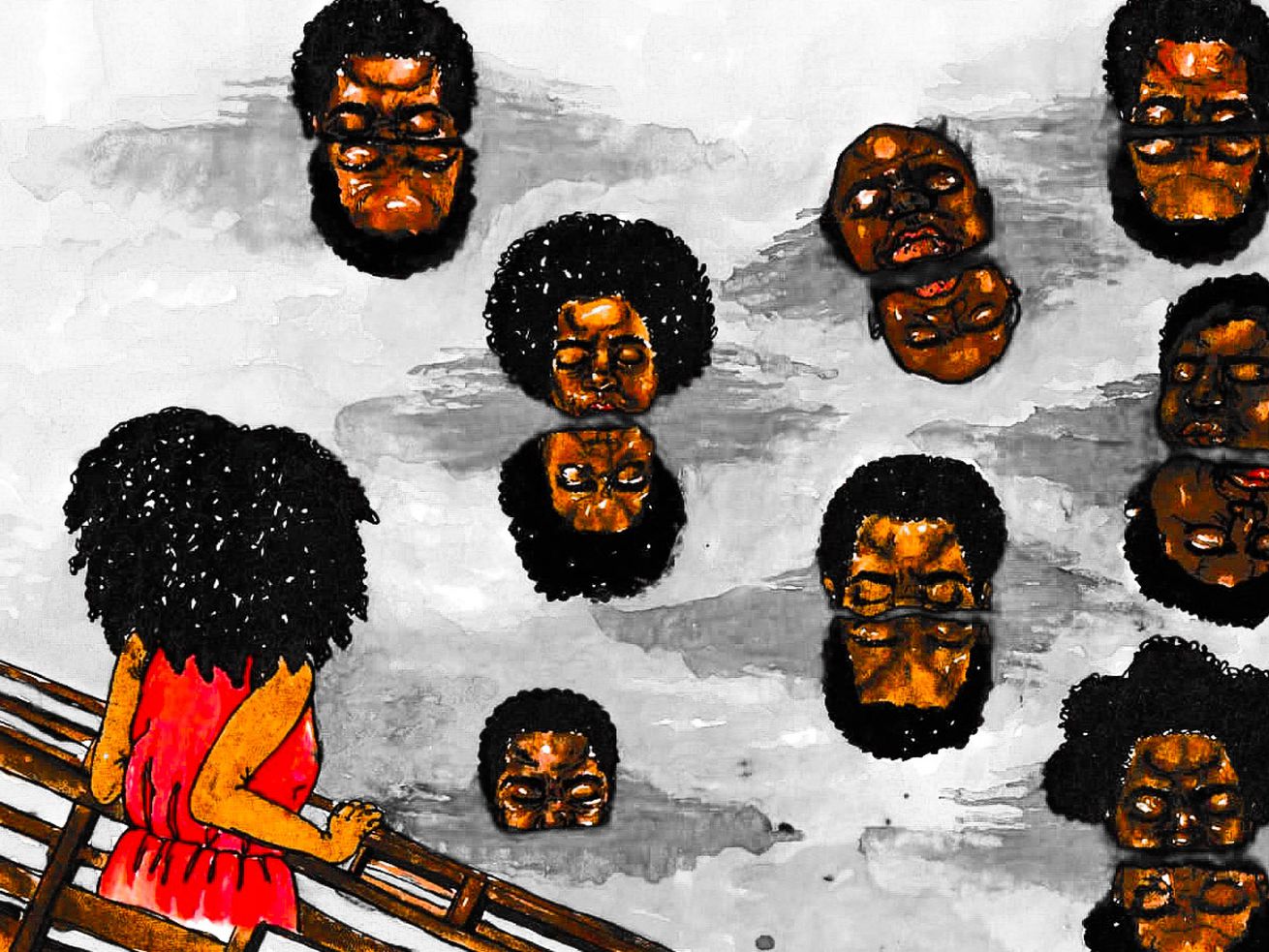On the Georgia coast, leisure and a grim history of slavery co-exist.
/cdn.vox-cdn.com/uploads/chorus_asset/file/21899595/VOX_The_Highlight_Box_Logo_Horizontal.png)
Part of the Leisure Issue of The Highlight, our home for ambitious stories that explain our world.
My debut as a tightrope artist came not on a twisted maze of natural fibers and yarn but on the concrete slatted bridge, misty air jutting through the cracks, over Dunbar Creek in St. Simons Island, Georgia. It was here, in 1803, that an estimated 75 captive Igbo Nigerians opted to dance with the depths of the water, to walk until they could walk no more, rather than live a life enslaved.
The small, otherwise unremarkable bridge on Sea Island Road sits above Dunbar Creek, where hundreds of cars pass over on an average day, bound for exploring St. Simons Island. It feels like nothing of significance or worth remembering; it is somewhere grotesquely beautiful that has been intentionally forgotten and neglected. I walked it at my own risk, trying to keep my balance on a narrow ledge, afraid, praying I’d make it the length of the bridge unscathed.
As I stepped off the bridge and back onto the sharp incline of rocks, sand, and mud, I felt saddened for reasons even I was surprised to admit to myself. It was not that this was a place where despair led to a lasting choice, but that the area was filled with trash and rotting construction signs rather than any commemoration for the lives that were lost. Cars continue to zoom over the bridge, over this smaller body of water, like nothing ever was.
Heading back to my car, which I’d haphazardly parked in a patch of grass right off the bridge, a calm settled over me. I knew why my ancestors had chosen this point in the water to make an impossible choice: This winding, murky creek offered them a kind of peace, a kind of stillness. A chance to both release and reclaim what had been ripped from them.
A part of Georgia’s Golden Isles, St. Simons is a 17.7-square-mile island off the Atlantic Coast in Glynn County. Halfway between Savannah and Jacksonville, the sprawling marshlands give way to sweeping coastal landscapes. Native Americans called St. Simons Island home before Spanish, French and English colonists wrangled over the land, and the English ultimately won their quest. Beginning in the 1790s, enslaved Africans cultivated the land on this island, growing and harvesting rice, sugar, and cotton, yielding a bountiful harvest for a nation that offered them nothing in return.
St. Simons Island — like the rest of the Golden Isles of Jekyll, Little St. Simons, and Brunswick — has beaches and coastlines stretching its full length. Lush oak trees and sagging weeping willows surround hotels, bed-and-breakfasts, and rental vacation homes that some visitors call their residences for months out of the year, typically in the summer. Luxury cars full of families traverse the island, while throngs of others walk or ride bikes on the tree-lined streets.
A place like St. Simons Island oozes idyllic Southern charm. The drawls are as grand as the morning sunrises and the evening sunsets over marshland, the swaying patches of brown and green grass cradling both mud and smaller tributaries of water. For such a small island, the days feel longer, especially in the summer, particularly when you’re strolling on East Beach, golfing on any of the six golf courses, or eating plentiful amounts of meaty coastal oysters, crab, lobster, and plump — and slightly sweet — Georgia shrimp.
The key to enjoying St. Simons is to embrace ease and relaxation — a slower pace of life. While ease and relaxation are easily embraced, the legacy of those who have been lost and exploited is visible in stray glances, if you notice, in things like restaurants or buildings made from tabby oyster shells, cream-colored and gritty in appearance. Slave cabins were often constructed from tabby. Yet the history is often obscured, like that of Igbo Landing.
The details and what happened at Igbo Landing — also referred to as Ebo or Ibo Landing — are too visceral, too real to be the result of families huddled together relishing in the age-old African art of storytelling. The water knows.
Dunbar Creek, the way it ripples and settles with ease, holds something other than fish, trash, mud, and marshland treasures. No one else was there when I visited, and from what I know, no one visits here often — although it’s a stone’s throw from some of St. Simons’s many vacation homes and a plaza with a CVS and a grocery store.
I learned the story at the National Museum of African American History and Culture in Washington, DC. Months after the museum opened in 2016, my father lucked out with coveted tickets, and my family braved the cold and the long lines Thanksgiving weekend.
One of my sisters and I began at the very bottom of the museum, where the oldest histories are housed. A dimly lit space that felt more like a claustrophobic ambling in the dark, it echoes what it might have felt like on a slave ship on a brutal journey to an unknown land, stolen from the only home you’d known. It was there, pausing somberly and squinting to read the placards, that I read about a group of Igbo Nigerians — from whom I am descended and who I consider my ancestors — who made the Middle Passage journey to Savannah. These roughly 75 people were boarded upon a smaller ship, bound for St. Simons Island. Once the ship arrived, those held captive took control of the ship. As this story of resistance goes, shackled and connected to one another, they walked into the waters of Dunbar Creek chanting in Igbo, “The Sea brought me and the Sea will take me home.”
Aside from my immediate sadness in reading about it, I felt something else rising to the surface — my ears started to ring, my hands trembled, my face grew hotter, my heart began to race so fast I had to take deep breaths to steady myself. I was filled with endless questions.
Why was this the first time I’d heard about this? Why hadn’t we been taught about the horror of what happened that day on Georgian soil, mere hours from where I grew up?
Not knowing is a violence.
The absence of knowing robs you of the chance to mourn, to grieve. We lose our humanity, the space to be bereft, the chance to avenge and honor our ancestors, to fight for their legacy to live among everyday consciousness. These are our losses when our histories are not told, shared, or known by those they directly affect.
This is the case for Igbo Landing, which rightfully could be considered a slave rebellion. It is one instance among many in which those due to be enslaved fought back, who made an impossible choice faced with a litany of unthinkable decisions.
In recent years, popular culture has brought the story of Igbo Landing in front of both Black and white audiences, even if it didn’t appear that way on the surface. The same year I learned of Igbo Landing for the first time, it seemed to garner a reference in Beyonce’s genre-shifting work Lemonade. “Love Drought” begins with an ethereal image of women walking solemnly into the water in a straight line behind one another. They are adorned in all white with black sashes at their waist in the shape of a cross. The walk is shown to be a ritual, a communing with the water.
Black Panther also touched on the story of Igbo Landing, when Michael B. Jordan’s character, Killmonger, said words that have been repeated with fervor since — “Bury me in the ocean with my ancestors that jumped from the ships because they knew death was better than bondage.”
The references to Igbo Landing, whether blatant or suggestive at best, go even further back. Julie Dash’s Daughters of the Dust, released in 1991 and praised because of its emphasis on the complexities of Black womanhood, is set in Igbo Landing, and its Peazant family members are direct descendants of the enslaved there.
Six years earlier, Virginia Hamilton published The People Could Fly, a compilation of African American folktales that included Igbo Landing. Black people flying and taking to the skies is popular in folklore, because our ancestors imagine a life and world where we were free: the open skies, the blue waters of the ocean, the murky ones of Dunbar Creek. Being elsewhere meant that they had choices other than a certain death trapped in a system that worked to devalue, demean, and break their spirits.
These references to Igbo Landing through the years serve as remembrance, a true recollection of what happened at Dunbar Creek — of what happened in St. Simons Island all those years ago — depending on whom you ask.
Toni Morrison once said, “All water has a perfect memory and is forever trying to get back to where it was.” I thought about this as I stood over Dunbar Creek, craning my neck to take in the area and memorialize what I saw with my camera. My shutter clicked as I swatted mosquitoes from my face and attempted to distract myself from being inches away from cars driving by at full speed. One stumble in the wrong direction and I’d be flung into oncoming traffic — or down below into water so murky I couldn’t be sure of the depth.
I was terrified. But I desperately wanted to remember. I wanted to recall a space, place, and time that I had not known. And I was convinced this moment would connect me to something bigger. The water had something to teach me: about pain, the weight of forgetfulness, and existing in a space of liminality.
There is deep irony in places like St. Simons Island. Families and friends road-trip to this island, where they can feast on seafood and drink cheap beers in timeshares, or in second or third homes. This is their version of paradise and relaxation, leisure and ease they have earned. Leisure they feel a right to. But this leisure is decidedly white in its aims.
That weekend this summer, I didn’t see many Black people on St. Simons Island. They exist. They go there, too. But a coastal island in the marshlands of Georgia, St. Simons has a particular history that cannot be erased, because of its proximity to water and its connection to slavery. Places like these were prime real estate because of their ease of connection to precious cargo. Humans were shuttled like animals, chained and shackled, and sold. Sometimes they were held in slave depots until they could be sold or a sale was finalized — these were our earliest prisons.
Multiple truths, different versions of truth, can coexist. Concepts like leisure and rest shouldn’t fall into that category, and yet they do.
As in so many other places that are vacation and getaway central, Black leisure doesn’t exist here. Not when our pain is not validated and is instead erased. Not when Igbo Landing itself is largely inaccessible due to private land disputes.
My first few attempts to access Dunbar Creek via the bridge on Sea Island were dead-end, fruitless chases. Multiple times, I ended up on the other side of a wastewater plant, which has been there since the 1940s. The more direct route landed me tightrope-walking on that bridge — the closest I could get, since the area is on multiple acres of private property. That is why there is not even a commemorative marker.
The Saint Simons African American Heritage Coalition wanted to do something about that. In 2002, the group invited 75 people to pay homage to those who died at Igbo Landing and included some discussion on Igbo customs and traditions, in the hopes of giving the spirits lingering near the water some rest. Some of the coastal schools have also incorporated the story of Igbo Landing into their curricula. But there’s still so much to be done. Official marking would seal the history.
When I arrived back in Atlanta, where I live, the sand gathered underneath my feet on my car mat felt like a ceremonious parting gift. A trinket, a souvenir, a sentimental, heart-strung charm for the road, so that I never forgot what I saw, never forgot what it felt like to be there, breathing in that air, taking in that same view that my ancestors took in centuries ago. I felt connected because I had chosen to be a witness to their pain — and to their ultimate glory.
Nneka M. Okona is a contributing writer for the Counter and the author of “Self-Care for Grief.” She previously wrote about “heritage” tourism among African Americans for The Highlight.
Author: Nneka M. Okona
Read More



